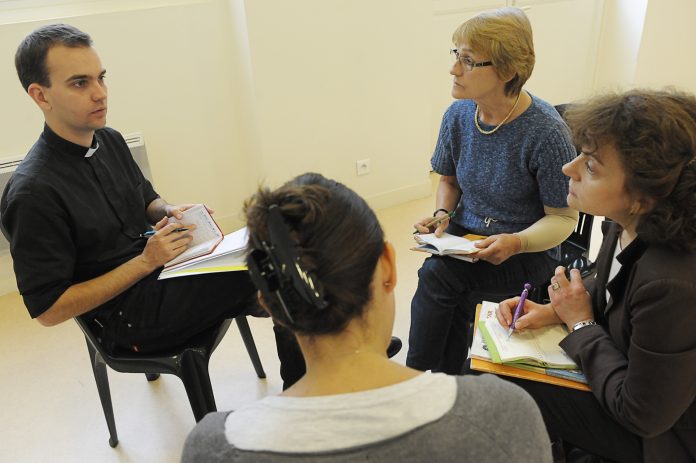
Plan this retreat for catechists involved in sacramental formation
BY DEANNA BARTALINI
Catechists work hard. They share their faith and knowledge, and they give up personal time to plan lessons, be at class, and pray for their students. They echo the faith to our children, young people, and adults. Parish catechetical programs would not be possible without their generous service. As a parish catechetical leader, I’ve learned that one way to show our appreciation is to help our catechists fill their spiritual needs. A retreat is a great way to do that
TARGET AUDIENCE AND GOALS
Te following retreat is designed for catechists and helpers who prepare children and youth receiving the sacraments of Penance and Reconciliation, Eucharist, and Confirmation. Yet other catechists or liturgical ministers would also benefit. It will give catechists the opportunity to reflect on what the sacraments mean to them, learn more about what the Church teaches about the sacraments, renew their spirits, and get to know other catechists.
PLAN AHEAD
Plan each talk by reading the Scripture and Catechism references provided in the “Retreat Schedule” box on this page. Note the points you want to cover with your group. Each talk has scheduled times for questions from the group and refection. Recruit others to help with the talks if you wish. You do not need to lead the retreat all on your own. You’ll find notes for supplies needed and optional activity information in boxes on the next two pages.
RETREAT SPACE
Set up your space as a welcoming room with space for both small and large groups. Have music playing as people enter, and make refreshments available. At the welcome table have a sign-in sheet, name tags, and a prayer basket for each person to put in their name. A prayer space in the front of the room with a candle, a cross, a patron saint, fowers, and a Bible provides a focus point. If you have the equipment available, use a projector to put the prayers, Scripture, songs, and questions on a screen; if not, have handouts for the group. Place a Bible and a Catechism at each table for reference. Refection questions can be discussed in small groups so people have an opportunity to get to know each other.
RETREAT OUTLINE
STEP 1: OPENING PRAYER (10 minutes): Welcome your group again and begin the retreat in prayer. Ask your listeners to remember what words or phrases resonate with them as they pray Psalm 19. Divide the group in half and have each group read one verse at a time, switching back and forth. Allow time for refection. Invite people to come forward and write the word or phrase from the psalm on a chart tablet or butcher paper. Play a song as they do this. When done, offer a brief spontaneous prayer, using what was written by the catechists.
STEP 2: ICE BREAKER (10 minutes): Break up into groups of four to six people and have each person answer the question: What is your most memorable sacrament experience?
STEP 3: EUCHARIST TALK (30 minutes): Begin with the Eucharist because it is “the source and summit of the Christian life” (CCC, 1324). Open the talk with the Bread of Life discourse from John 6:25-69. Ask the group what the Eucharist means to them. Ten offer your talk, with the following points:
✱ Te Eucharist is the ever-present sign that our Lord is with us. It causes us to change, to become more like Jesus. It is our spiritual food.
✱ This sacrament has many names: Eucharist; the Lord’s Supper; the breaking of the Bread; the Holy Sacrifice; Holy Communion. Each name points to a specific meaning and purpose, reminding us of the many reasons Jesus gave us his Body and Blood (see CCC, 1328-1332).
✱ Discuss transubstantiation using paragraphs 1373-1377 from the Catechism.
REFLECTION QUESTIONS: How does the Eucharist help you in your daily life? Do you think we sometimes take the Eucharist for granted? How can we avoid doing that? What do you think is the most important thing about the Eucharist to convey to your class? (Afer the talk, take a 10-minute break. Refreshments here are a plus!)
STEP 4: CONFIRMATION TALK (30 minutes): Ask the group to tell you what they know about the sacrament of Confirmation. Be sure to ask about the gifs of the Holy Spirit. As they respond, write down their answers for the group. Use the answers as a springboard to make the following points in your talk:
✱ Confirmation is necessary for the completion of baptismal grace. It enriches us with a special strength of the Holy Spirit, and it binds us more closely to the Church (see CCC, 1285).
✱ Preparation for Confirmation should lead a Christian to a closer relationship with Christ and a greater understanding of the role of the Holy Spirit in one’s life. The goal for those we prepare is “to awaken a sense of belonging to the Church of Jesus Christ, the universal Church, as well as the parish community” (CCC, 1309)
REFLECTION QUESTIONS: How did Confirmation strengthen your faith? How is what the Church teaches about Confirmation the same or different from what you have understood in the past? For those preparing for Confirmation, how can the sacrament be less about “graduation” from religious education classes (as some view it) and more of a deepening of faith?(After this session, offer a brief 5-minute stretch break.)
STEP 5: PENANCE AND RECONCILIATION TALK (30 minutes ): Begin with questions: What is your earliest memory of going to Confession? Was the experience positive or negative? What are the benefits of receiving the sacrament? Read John 20:19, 22-23 where Jesus gives the apostles the ability to forgive sins. Discuss that briefly. Begin the talk using these points:
✱ The sacrament is called a sacrament of conversion, penance, confession, forgiveness, and reconciliation (CCC, 1423-1424).
✱ What is sin? It is “missing the mark”; it separates us from God (see CCC, 1440, 1849-1851). What is the difference between mortal and venial sins? (see CCC, 1854-1864). Why confess venial sins?
✱ What is necessary in the sacrament of Penance and Reconciliation? Contrition, confession of sins, and satisfaction (see CCC, 1450-1460).
REFLECTION QUESTIONS: What is difficult to get across when teaching
about this sacrament? How can you help others understand that God is both just and forgiving? (Offer another 10-minute break after this session.)
STEP 6: SACRAMENT SIGNS AND SYMBOLS ACTIVITY (20 minutes):
✱ In small groups, have the catechists brainstorm and list the items (matter) used for and the symbols associated with each sacrament, one sacrament at a time. Do this on large chart paper, one sheet per sacrament.
✱ Put up each list and discuss what was written. Circle those things that are used in all the sacraments. Highlight the importance of those items or actions. Also lead the catechists to notice how the “matter” used for sacraments is often the very ordinary things of life—for example: water, bread, wine, oil, people.
REFLECTION QUESTIONS: Why do you think we use such ordinary things in the sacramental life of the Church? What does this show us about the link between the sacraments and our own lives?
STEP 7: CLOSING SESSION AND PRAYERS (20 minutes):
✱ Discuss with the large group the most important thing learned today and how they can use some of it with their own classes.
✱ Read 2 Timothy 1:6-14. Play a song, and as the song is playing, have each person come up and take a name of someone from the prayer basket, and ask them to pray for that person going forward. Close with traditional prayers. Tank everyone for coming and for their service.
ADDITIONAL resources:
Supplies Needed
Office items: Name tags, pens, sign-in sheet, chart or butcher paper, markers, small slips of paper, basket (for names)
Handouts: Prayers, reflection questions, space for notes
Prayer table items; Bibles; Catechisms
Refreshments
Retreat Schedule:
1. Welcome and opening prayer
2. Ice breaker
3. Eucharist talk
(Break)
4. Confirmation talk
(Short Break)
5. Penance and Reconciliation talk
(Break)
6. Sacrament signs and symbols
7. Closing session and prayers
Scripture and Catechism References:
Eucharist talk
Scripture: Matthew 26:17-30; Mark 14:22-26; Luke 22:17-20, 24:13-35; John 6, 13:1-4; Acts 2:42-47; 20:7; 1 Corinthians 11:23-29
Catechism: 1322-1419
Penance talk
Scripture: Isaiah 22:22; Matthew 16:19-20, 18:10-19, 28:18; Mark 2:5-10; Luke 15; John 20:19-23; 2 Corinthians 2:10
Catechism: 1422-1498
Confirmation talk
Scripture: Isaiah 11:2-3; John 6:27; Acts 1:1-5, 2:1-4, 2:8, 19:6; Ephesians 1:13, 4:30; Revelation 9:4
Catechism: 1285-1321
Optional Activities:
Song Options (these are all on YouTube): Matt Maher: “Hold Us Together,” “All the People Said Amen”; Sarah Hart: “Love Moves You”; Ben Walther: “For God So Loved the World”; “A Place at Your Table”; Dan Francis: “He Is Love.”
Optional Activities: If a priest or deacon is available to help, have a time of Adoration with Confession, or start the day with Mass. Ask them to give a talk or offer the group a blessing.
Deanna Bartalini, M.Ed and MPA, is a faith formation director in the Diocese of Palm Beach, Florida. She’s a writer and speaker at DeannaBartalini.com.
Image credit: Corinne Simon / CIRIC




